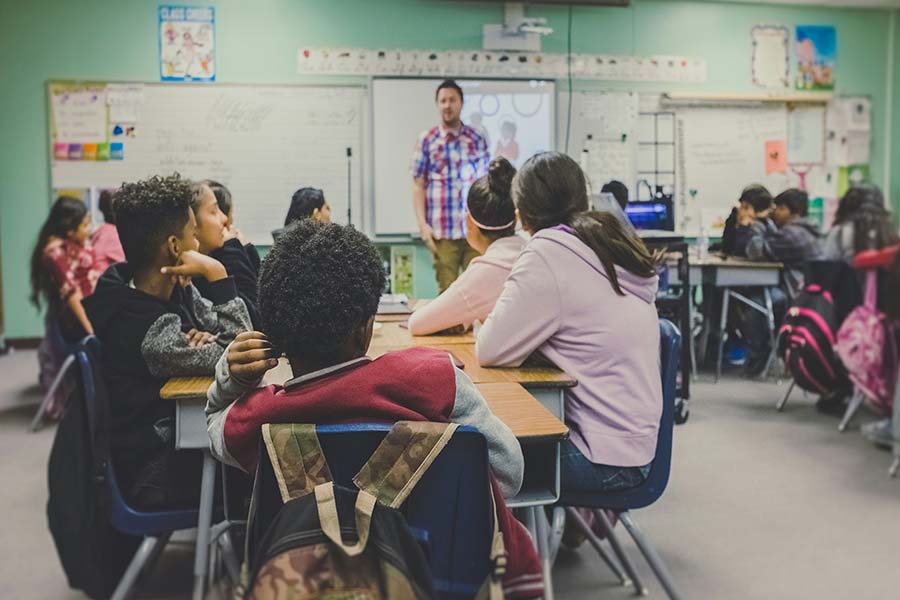Revolutionising Education: Tech’s Game-Changing Impact on Future Learning!

In recent times, technology has sparked a revolution across multiple facets of our lives, and education is no exception. We currently inhabit an era where technology significantly shapes education, altering the dynamics of student learning and teacher instruction. Delve into this article as we examine the profound influence of technology on education and its potential ramifications for the future of learning.
Enhancing Access to Education
One of the key benefits of technology in education is its ability to enhance access to education for individuals across the globe. With the advent of online learning platforms, students no longer need to be physically present in a classroom to acquire knowledge. Technology has paved the way for distance learning, allowing students to access educational resources and participate in virtual classrooms from any location with an internet connection.
Moreover, technology has made education more accessible to marginalised communities and individuals in remote areas. Historically, students living in rural or underserved areas often faced limited educational opportunities due to geographical barriers. However, with the help of technology, these students can now access quality education that may have otherwise been inaccessible to them. By leveraging online learning platforms, educational institutions can bridge the educational gap and empower individuals with knowledge and skills that can transform their lives.
In addition to increasing access, technology has also made education more flexible. Traditional classroom settings may only cater to the needs of some students, such as those with work or family commitments. Online learning allows individuals to pursue education at their own pace and schedule. This flexibility enables students to balance their responsibilities while acquiring knowledge and skills.
Personalised Learning
Technology in education has opened up new possibilities for personalised learning. With the help of various digital tools and adaptive learning platforms, educators can tailor their teaching methods to meet individual student’s unique needs and learning styles. This personalised approach to learning enhances students’ understanding and promotes their engagement and motivation.
By analysing student performance data, technology can identify areas where students need additional support and provide targeted resources to address those gaps. For example, suppose a student is struggling with a particular concept. In that case, adaptive learning platforms can generate customised practice exercises or recommend additional resources to help the student grasp the concept better. This individualised attention and support can significantly improve students’ learning outcomes.
Furthermore, technology allows students to learn at their own pace. Teachers often need to follow a predetermined curriculum in a traditional classroom setting. They may need help to adjust their pace according to individual students’ needs. However, with technology, students can progress through the material comfortably. This ensures that students fully understand the concepts before moving on, reducing the likelihood of knowledge gaps.
Interactive Learning Experiences
Gone are the days when education solely relied on textbooks and lectures. Technology has revolutionised the learning experience by providing interactive and immersive learning opportunities. Using simulations, virtual reality, and augmented reality, students can now explore various subjects hands-on and engagingly.
For example, biology students can take virtual field trips to study different ecosystems, immersing themselves in the environment and observing the organisms in their natural habitats. This enhances their understanding of the subject and sparks their curiosity and enthusiasm for learning. Similarly, history students can virtually visit historical landmarks and experience significant events, bringing the past to life and making the learning experience more vivid and memorable.
In addition to simulations and virtual reality, technology enables interactive discussions and activities. Online platforms and tools offer live chats, discussion forums, and collaborative document editing, allowing students to participate and engage with the learning materials actively. This fosters critical thinking, problem-solving, and communication skills, essential for success in the modern world.
Collaboration and Communication
Technology has also facilitated collaboration and communication among students and teachers. Online platforms and tools enable seamless communication between educators and their students, fostering an interactive and supportive learning environment. Students can contact their teachers for clarification or guidance outside regular class hours, promoting continuous learning and support.
Moreover, technology allows students to collaborate on group projects regardless of location. Through video conferencing, shared document editing, and online collaboration platforms, students can efficiently work together, exchange ideas, share resources, and complete assignments as a team. This enhances their teamwork and interpersonal skills and exposes them to diverse perspectives and ways of thinking.
Collaborative learning also prepares students for the real world, where teamwork and effective communication are essential in many professional settings. By leveraging technology to facilitate collaboration, educators are equipping students with the skills they need to succeed in their future careers.
Access to a Wide Range of Resources
The internet has become a treasure trove of information, offering students access to vast resources beyond traditional textbooks. Online libraries, academic databases, and educational websites provide students with limitless opportunities to expand their knowledge on various subjects.
Students can access articles, research papers, videos, and multimedia resources that supplement their classroom learning with just a few clicks. This wealth of information allows students to delve deeper into a topic, explore different perspectives, and develop a more comprehensive understanding. Moreover, technology enables students to access up-to-date information, ensuring their learning is not limited to outdated materials.
In addition to online resources, technology offers various educational software and applications that enhance the learning experience. For example, language learning apps provide interactive lessons, quizzes, and pronunciation exercises to support language acquisition. Mathematics software offers interactive tutorials, simulations, and practice exercises to help students grasp complex mathematical concepts. These resources cater to different learning styles and preferences, providing students with diverse opportunities to enhance their understanding and skills.
Preparing Students for the Future
Incorporating technology into education is crucial in preparing students for the future. In today’s rapidly evolving world, technological literacy is becoming increasingly important. By integrating technology into the classroom, students acquire essential digital skills vital for their workforce success.
Basic computer literacy is now a fundamental requirement in many job roles. Students must proficiently use productivity tools, navigate online platforms, and understand digital etiquette. Additionally, as technology advances, skills such as coding and programming are becoming increasingly valuable. Educators are equipping students with the tools to navigate an increasingly digital society by introducing them to coding languages and programming concepts.
Moreover, technology fosters critical thinking, problem-solving, and creativity, highly sought-after skills in the job market. By engaging with technology in educational settings, students develop their analytical and innovative abilities, enabling them to adapt to new challenges and contribute to the advancement of society.
Addressing Learning Challenges
Technology in education can address various learning challenges students face. For example, students with learning disabilities can benefit from assistive technologies that provide additional support and accommodations. These technologies include text-to-speech software, speech recognition tools, and assistive devices that facilitate reading, writing, and comprehension.
By using technology, educators can create inclusive learning environments that cater to the diverse needs of students. For instance, students with visual impairments can use screen readers to access digital content. In contrast, dyslexic students can utilise text-to-speech software to improve their reading comprehension. These assistive technologies level the playing field for students with disabilities, allowing them to participate in learning and reach their full potential fully.
Furthermore, technology offers personalised interventions and remediation for struggling students. Adaptive learning platforms can identify areas of weakness and provide targeted resources, practice exercises, and feedback to help students improve their understanding and skills. This individualised support ensures that every student is included and that each student receives the specific assistance they need to succeed.
Overcoming Geographical Barriers
Technology can overcome geographical barriers and bring education to remote and underserved areas. By leveraging online learning platforms, students in rural areas or developing countries can access quality education that may have been inaccessible. This has the potential to bridge the educational gap and empower individuals with knowledge and skills that can transform their lives.
In regions where educational resources are scarce, technology offers a lifeline. Students can access digital textbooks, educational videos, and interactive lessons, providing them with educational opportunities that were previously out of reach. Additionally, online platforms offer opportunities for collaboration and interaction with students worldwide, fostering cultural exchange and global awareness.
Moreover, technology enables teachers in remote areas to connect with experts and resources worldwide. Through video conferencing and online professional development programs, teachers can access training and support that enhances their teaching practices. This empowers educators to provide high-quality education to their students, regardless of location.
Challenges and Considerations
While integrating technology into education has numerous benefits, it also poses specific challenges and considerations. Some of these include:
Cost: Implementing technology in education requires significant financial investment, including purchasing devices, software licenses, and infrastructure upgrades. Schools and educational institutions must allocate sufficient resources to ensure equitable access to technology for all students.
Equity: Ensuring equal access to technology and bridging the digital divide remains challenging, especially in disadvantaged communities. Schools and policymakers must work together to provide equal opportunities and resources to all students, regardless of their socioeconomic background.
Privacy and Security: Technology in education concerns students’ information privacy and security. Educational institutions must prioritise data protection and implement robust security measures to safeguard student data and privacy.
Digital Literacy: Educators must receive adequate training to effectively incorporate technology into their teaching practices and help students develop digital literacy skills. Ongoing professional development programs and support are necessary to ensure that educators can fully leverage the potential of technology to enhance student learning.
Screen Time: Balancing screen time and ensuring the judicious use of technology in classrooms is essential to prevent potential adverse effects on students’ health and well-being. Educators and parents must establish guidelines and promote responsible use of technology to maintain a healthy learning environment.
As we navigate through these challenges, it is essential to harness the full potential of technology in education while being mindful of its impact on students’ overall learning experience.
Conclusion
Technology has revolutionised education, transforming how students learn and teachers deliver their lessons. Technology offers many benefits, from enhanced access to education and personalised learning to interactive experiences and collaboration. Technology plays a pivotal role in shaping the future of learning by overcoming geographical barriers, addressing learning challenges, and preparing students for the future. However, it is crucial to acknowledge and address the challenges of integrating technology in education to ensure a balanced and inclusive approach to learning.
Check out our other related posts if you enjoyed this one.
- Enhancing User Experience: Dewalist Classifieds’ Commitment to Efficient Content Moderation
- Dewalist Soars to New Heights: A December 2023 Recap
- Dewalist Reaches 103 Users per Minute: A Google Analytics Record
- The Wealth of Nations by Adam Smith: A Word Book Summary
- Embracing Remote Work: Shaping Tomorrow’s Workplace
- Navigating Mental Health in the Justice System
- Tech’s Impact on Education: Shaping Future Learning
- Social Media’s Relationship Impact: A Digital Paradox
- Embracing Diversity: Building Inclusive Workplace & Society
- Introducing Our New and Improved Dewalist Marketplace Design
If you enjoyed this blog post, subscribe for updates and stay tuned for our latest insights.
Help your friends and colleagues stay informed about the newest insights on business, marketing, finance, lifestyle, and society by sharing our blog content through Facebook, Twitter, Pinterest, LinkedIn, email, or WhatsApp links below. We can create a knowledge-sharing community and empower one another to accomplish and experience our objectives.
FAQ
What are the benefits of technology in education?
Technology enhances education access, enables personalised learning, provides interactive learning experiences, and facilitates collaboration and communication.
How does technology enhance access to education?
Technology allows students to access educational resources and participate in virtual classrooms from any location with an internet connection. It also makes education more accessible to marginalised communities and individuals in remote areas.
How does technology support personalised learning?
Technology enables educators to tailor their teaching methods to meet individual student’s unique needs and learning styles. It provides targeted resources and allows students to learn at their own pace.
What are the challenges and considerations of integrating technology in education?
Some challenges include cost, equity, privacy and security, digital literacy, and managing screen time. These challenges must be addressed to ensure a balanced and inclusive approach to learning.
Credits
Featured photo by Kenny Eliason on Unsplash.









